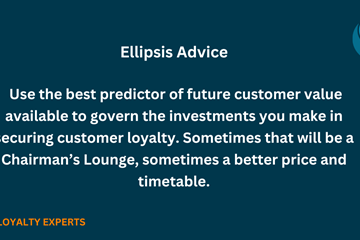The Critical Skill For A Data-Led Culture? Storytelling

"Without data you are just another person with an opinion. We will use mine’
The Ellipsis Loyalty Consultants recently attended a webinar at ANZ Bank. A question was asked... ‘what does it take to successfully introduce a data-led culture into a large organisation like ANZ?’. The refreshing answer included, ‘you need to be good at story-telling’. And if sometimes the story is a little ahead of the data, that is OK (it was implied). Engagement with the story is critical.
This did get us thinking about our range of customers, most of them on just such a journey to introduce increased levels of customer and/or data centricity to their operations. Several have the same system platforms installed but are at vastly different levels of sophistication in their use of data to drive effective marketing and service.
Perhaps story-telling skills are missing for some of them? The difference has to be cultural, developmental, and linked to their ability to tell stories from the data that are engaging for the marketing team and management.
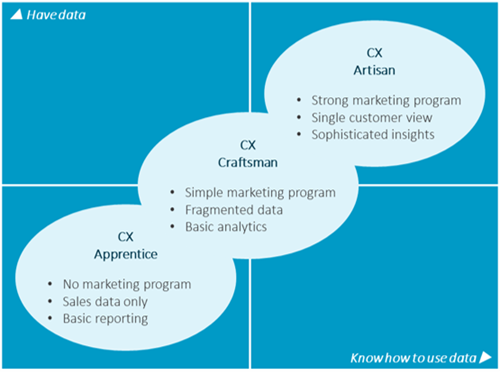
We often use this simplistic but useful grid to have customers self-evaluate their status as data led organisations2. Even allowing for the natural tendency of Marketers to be modest… we rarely find a customer who considers themselves an Artisan. There are some Craftsmen we agree, and many aspiring Artisans have already implemented the technology needed, but the organisational thinking and culture has not caught up.
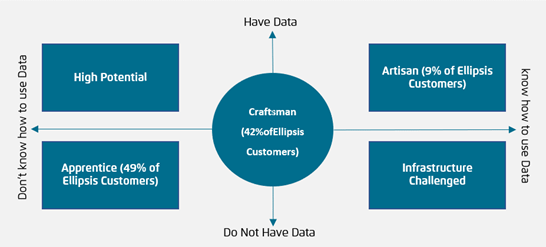
So, we did what we do when something interesting catches our eye; a literature search to see if the journey to becoming a ‘Data Artisan’ has been formally studied before. We found two thought-provoking references.
The first caused a wry smile of recognised truth…
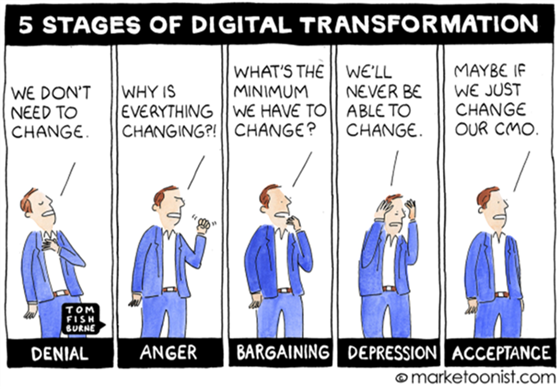
The second is more quantitative, a study published in the Journal of Research in Interactive Marketing in 20193.
5 Steps To Marketing Big Data Analytics
This study found a 5-step journey that organisations take as they implement ‘Marketing Big Data Analytics’. The stages ring true to our experience and may help you work out what is next in your own journey, what to expect next. The 5 stages are:
1. Sprouting
When firms lack C-suite data analytics expertise, interest in analytics usually comes from junior management, especially recent recruits.’4
There is a tale in Ellipsis of the company that entered the "Sprouting" phase due to an influx of bright new graduates, who conducted a ‘proof of concept’, to demonstrate to the Board that a data-driven approach to marketing could be profitable.
The marketing team segmented their customers, and built propensity models for the most distinct segments, matched to ‘next best offers’ (NBOs). Good campaign design allowed them to measure lift against control and run the campaign as a test.
This was meticulously presented to the Board, who listening politely but seemed to 'glaze over' as the principles were explained.
Until the results were unveiled: the conversion rates on the POC were outstanding, many times better than standard campaign results.
To which a Director excitedly announced; "this result is so good, let's make this offer to all our customers!"
Do not forget the story-telling and education required for sprouts to take root and remember that new data-competent recruits may not have the other skills required to ‘tell a good story’. A balance of raw knowledge and enthusiasm with experience and perspective of the wider business makes for the best storytelling.
2. Recognition
‘…the efforts of early analytics champions begin to show results, and sections of the organization begin to grasp the importance of data analytics investments for growth. This stage is usually influenced by discussions with outside consultants who explain the journey to becoming data-driven and the need for data warehousing as a basic hurdle.’
A recent experience for an Ellipsis client as an example. This customer had good results in increasing engagement and loyalty through targeted loyalty initiatives and programs. A desire to lift these results even further made it clear they needed to combine several platforms that existed as a legacy of multiple company acquisitions over-time.
Management recognised the inability to improve customer service and lift retention rates without a single view of each customer, so are making the investment required and will implement an LTV-driven strategy following this infrastructure build, moving to the Commitment Phase.
At this stage, we recommend you increase the intensity of data-led storytelling – actually painting the picture of ‘what good looks like’ but this time based on facts from your own experiences and tests. Move the stories from conjecture and the hypothetical to ‘we found this and therefore can project…’ to rally support for the cultural changes that are yet to come.
3. Commitment
In this phase, management has ‘got it’ and demonstrates strong support for the data initiatives, funding data warehouses and staffing that includes analytics professionals and consultants. The ‘proof of concept’ phase is over, and management can see the returns on offer. This is also the stage where data analysis becomes an organisation-wide priority, not a project in Marketing.
If your organisation is complex, the extension of the data centric culture to multiple departments poses challenges of scale. Do not leave this to chance, address each functional team in line with their commitment and the degree of change being suggested. We have found this 2x2 useful in planning the internal plans required to persuade and inform the critical teams as change is attempted5.
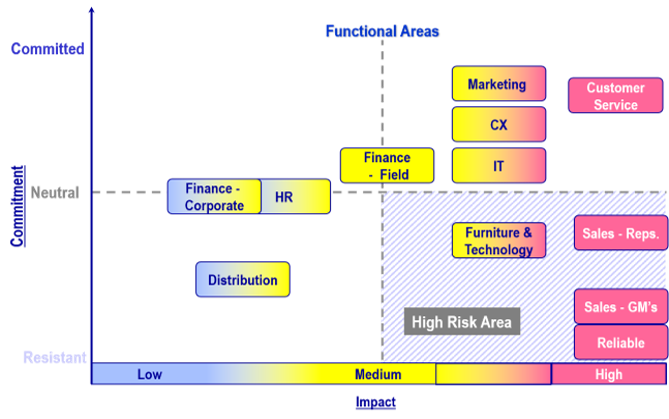
It is also useful to determine which individuals are Change;
Sponsors – ask for their authority
Agents – use their passion to reinforce the positive stories
Advocates – publicise their support
Targets – spend most of the effort on these colleagues to help & educate
4. Culture Shift
“Culture eats strategy for breakfast.”6
At this stage, the organisation has an appreciation of analytics and its potential, but the final step requires a cultural change7 For the researchers, this change is highlighted by the shift of data analytics from descriptive to predictive, indicated by the presence of Data Scientists in the team. There is a word of warning at this stage; do not forget the importance of your brand in the relentless drive for short term ROI and do not succumb to the ‘Street Light Effect8’ where analysis is limited to areas where you already have good data.
A Sloan School article on creating data culture presented 5 recommendations on how to achieve this culture shift.
Five concrete ways leaders can constructively disrupt their workplace (paraphrased):
- Bring in a change agent. This can mean hiring someone like a chief digital officer, who are often serial innovators, coming into a company and shaking things up. This is a role with a high churn rate, as change agents tend to achieve success and then move on to the next challenge.
- Incentivise innovation. Companies should ask themselves how they approach innovation, making sure employees are not punished for trying new things. Successful firms embrace hackathons or invite teams to tackle hard problems and even celebrate failures.
- Confront brutal facts. How does your company culture respond when the numbers paint a bad picture? Successful companies avoid “vanity metrics” and hiding data that reflects poorly on their performance and instead address issues directly.
- Identify “what’s in it for me.” This means flipping the equation from a focus on the data to a focus on what the company needs — from “what data do I need?” to “what problems can I solve using data?”
- Organise for collaboration. Achieving results requires a collaborative approach, which means that some companies will need to reorganise around data and analytics. This might mean combining businesspeople with technical employees and coders.
5. Data-driven Marketing
Is achieved when ‘customer equity faithfulness’ is achieved; that is, each customer is treated according to their profit potential. The Sloan article also recommends making the company’s data FAIR9.
Findable: Findable data is often a main business problem and focus for Chief Data Officers, especially as silos lead to data repetition and lack of coordination. Security and data privacy are also dependent upon findable data.
Accessible: This relates to security roles, responsibilities, and ownership, and ensuring that data professionals are tasked with focusing on accessibility. In highly regulated businesses, it is important to ensure access is happening at the right discretionary level based on rules and governing principles.
Interoperable: Interoperability can be difficult, as it requires integration, but it presents an opportunity for firms to create relevance across data sources.
Reusable: Once a company has generated great data, it is important to ensure it can be used to its full potential value.
Lessons we can apply
- The quest for a data-driven culture is noble and the business results justify the effort. Better margins, more loyal customers, and more advocacy result from relentless personalisation and relevance. Speaking in August at the MIT Chief Data Officer and Information Quality Symposium, Chief Data Strategy Officer, Cindi Howson said data-driven companies enjoy increased revenue, improved customer service, best-in-class operating efficiencies, and improved profitability. “It sounds like what we all want and why we collect data at all,” she said.
- Neither culture nor technology is enough on its own. Many Ellipsis customers in the 'Apprentice' quadrant have the same technology tool stack as the 'Craftsmen' but combine these technological capabilities with robust underlying processes and skilled human resources..
- Story-tellers are critical employees on this journey to fully exploit the potential of data – we recommend you develop them or hire them. We call these people 'boundary-spanners', people with a foot in both the tech and management domains who can make each relevant to the other.
- There is a journey that Marketing undertakes to become data centric - the question for us is; is it possible to skip steps to accelerate the benefits? Since there are human-anchored critical success factors, perhaps not. 'Taking people on the journey' is more than a platitude, as collectively people are reluctant to abandon our comfort zone (or ‘cheese' to paraphrase the classic book ) for the new until we are sure it is better than the known. So, working to methodically demonstrate the advantages of being data-driven, reassuring the skeptical of returns, convincing with compelling stories is the lowest risk approach.
What do you think? What lessons have you learned on your journey to data-driven marketing?
We are Ellipsis, the Customer Loyalty Experts. We help businesses thrive through solving complex customer problems. Please get in touch, we’d love to talk.
References
1. ‘Talking Data with Emma Gray’, Melbourne Business School, August 27, 2020
2. With thanks to Rick Ferguson who created this, though he labelled the segments ‘Babies, Toddlers and Adolescents’ in his original Colloquy article.
3. The Marketing Organization’s Journey To Become Data-driven Johnson, Sihi, Muzelle & Zahay Vol 13, No.2 2019.
4. This story with thanks to Lee Ho Gan who was CEO at Market Data Science at the time
5. Peppers and Rogers, illustration only
6. Peter Drucker
7. ‘How to build a data-driven company’ Sara Brown. September 4, 2020
8. Named after the joke where the drunk is looking for his keys at night and is asked, ‘did you lose them where you are looking?’. He answers, ‘No, I lost them over there, but the light is better here by the streetlight’.
9.‘How to Build a Data Driven Company’ ibid 2020





